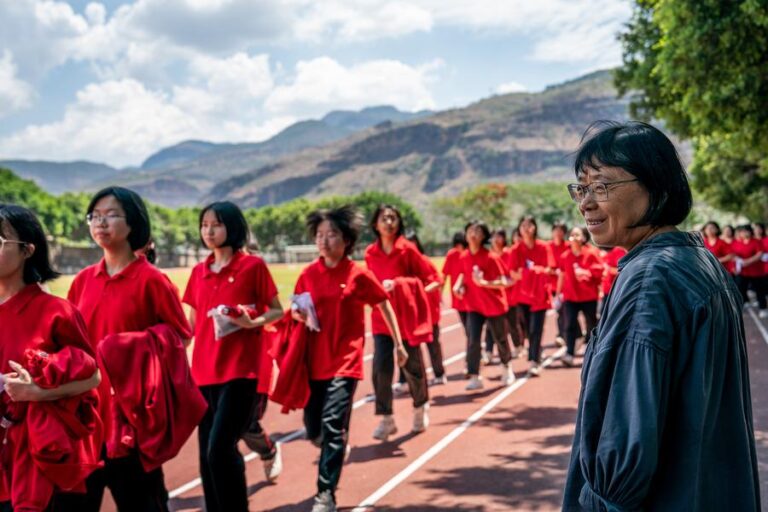China’s journey in advancing women’s rights is still unfolding. From Beijing to the world, it carries a message of hope and responsibility that empowering women is not only a national priority but a contribution to humanity’s shared future.
by Yi Fan
Thirty years after the landmark Fourth World Conference on Women adopted the Beijing Declaration and Platform for Action, China has not only voiced its commitment but also put words into action. The evidence lies not merely in policy documents or official statistics, but in the everyday stories of women who are overcoming barriers, seizing opportunities, and reshaping the future of their families, their communities and the nation itself.
SECURING RIGHTS, STRENGTHENING FOUNDATIONS
Each morning at Huaping High School for Girls in Yunnan Province, the schoolyard rings with a bold pledge, “I was born to be a mountain not a creek, rising to the high peaks with the valleys at my feet.” Behind that voice stands Zhang Guimei, the school’s founder. In her sixties and struggling with illness, she still devotes more than 18 hours a day to her students. Megaphone in hand, she has become a living symbol of how education can open doors that poverty once closed.
Her example is echoed nationwide. Gender disparity in compulsory education has virtually disappeared. Since 2015, girls’ enrollment in primary school has held steady above 99.9 percent. Women now account for nearly half of university students, with a growing presence in science, technology, engineering and mathematics fields once almost dominated by men.
Healthcare tells another chapter of progress. Over 480 million women have benefited from free screenings for cervical and breast cancer. The maternal mortality rate has dropped to 15.1 per 100,000 live births, outperforming many upper-middle-income countries. These advances are anchored in law: the 1950 Marriage Law enshrining gender equality and marital freedom; the 2016 Anti-Domestic Violence Law introducing personal safety protection orders; and the 2022 revision of the Law on the Protection of Women’s Rights and Interests, which explicitly bans workplace discrimination. In China, legal guarantees have become women’s lived realities.
BREAKING BARRIERS, DRIVING INNOVATION
From research labs to the far reaches of outer space, and from remote villages to online platforms, women in China are refining the nation’s development story. Nobel laureate Tu Youyou’s discovery of artemisinin has saved millions of lives worldwide. Astronaut Wang Yaping, China’s first woman to perform a spacewalk, inspired children across the nation by teaching from orbit. Meanwhile, vlogger Li Ziqi brought traditional Chinese culture to the world, enchanting more than 27 million subscribers.
Just as striking is the transformation brought by the digital economy. Today, 57 million Chinese women are active in e-commerce, live streaming and digital trade. Tencent’s WeChat alone has generated 14.47 million jobs for women. More than half of all digital entrepreneurs are female, many from rural regions, where online business means not only financial independence but new vitality for the local economy.
SHARING EXPERIENCE, ADVANCING TOGETHER
China’s commitment to gender equality has never been inward-looking. Since ratifying the Convention on the Elimination of All Forms of Discrimination against Women in 1980, it has sought to align national progress with global responsibility. Working with UN Women, UNDP, and other international partners, China has trained hundreds of thousands of women from more than 180 countries and regions, sharing expertise in maternal health, education and entrepreneurship.
At the same time, homegrown programs have become models for the world. The Spring Bud Project, launched in 1989, has enabled 4.36 million girls to return to school with the support of 3.44 billion yuan (roughly 483.52 million U.S. dollars) in funding. The Mother’s Water Cellar Project has delivered clean water to 3.95 million women and their families in drought-stricken areas. These experiences, rooted in China’s own journey of development, are now being prompted through South-South cooperation. Whether through e-commerce initiatives that reduce poverty or education programs that empower rural girls, China continues to offer practical solutions. As UN Women Executive Director Sima Bahous remarked, “China’s experience in promoting gender equality offers valuable lessons for the world.”
LOOKING AHEAD, BUILDING ONE SHARED FUTURE
Three decades after the Fourth World Conference on Women, Beijing is well prepared to host the Global Leaders’ Meeting on Gender Equality and Women’s Empowerment. The upcoming global gathering is both a celebration of what has been achieved and a reminder of what remains unfinished. The vision of a world free from gender discrimination and built on inclusive development is yet to be realized. That said, the progress already made shows what could be achieved when determination, innovation and solidarity come together.
China’s journey in advancing women’s rights is still unfolding. From Beijing to the world, it carries a message of hope and responsibility that empowering women is not only a national priority but a contribution to humanity’s shared future.
Editor’s note: Yi Fan is a Beijing-based political commentator.
The views expressed in this article are those of the author and do not necessarily reflect the positions of Xinhua News Agency.■

